For this edition of Classic Steel we are going to take a look back one of Kawasaki’s mid-nineties mid-range maulers, the 1996 KX250.
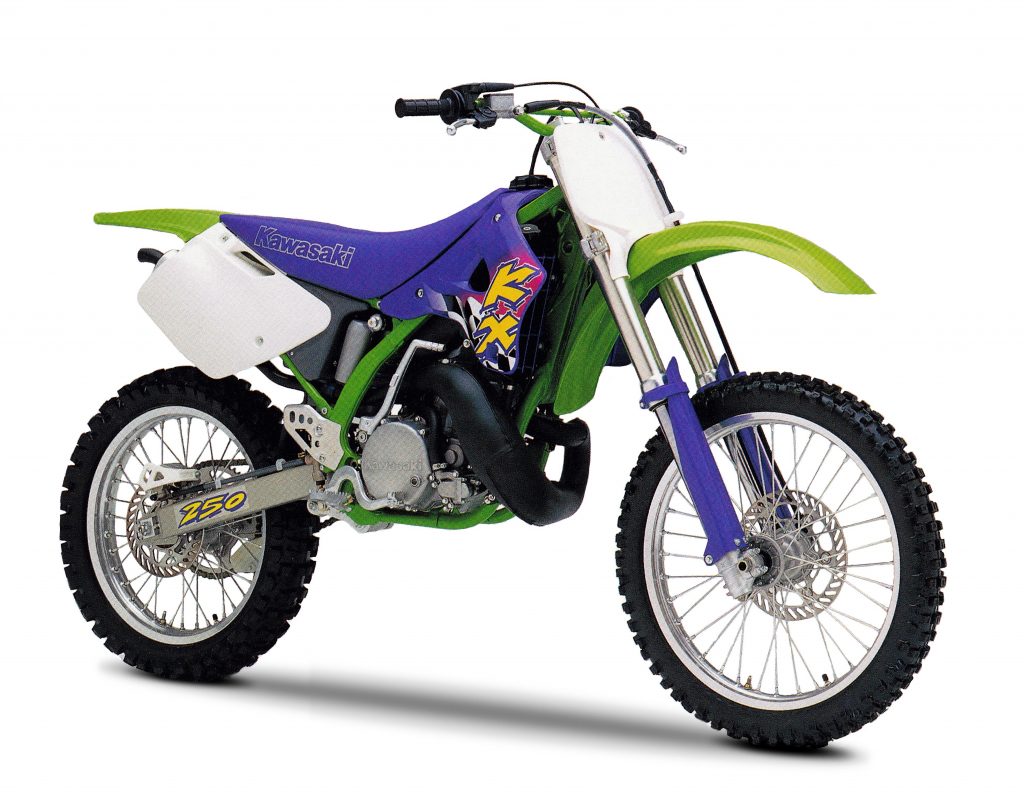
Purple was all the rage in the nineties and Kawasaki went all-in in 1996. Although fresh in appearance, the basic machine was only mildly updated from the year before. Photo Credit: Kawasaki
The nineties were an odd time for motocross aesthetics. After the ceaseless innovation of the seventies and eighties, it seemed that the manufacturers decided to turn to bold new styling to move their machines off the showroom floors in the early nineties. No longer able to triple travel and reinvent the wheel every other year, the Big Four instead relied on outrageous graphics and psychedelic colors to keep the masses interested. Pink Hondas. Magenta Yamahas and zebra-striped Suzukis all became the norm as the Japanese doubled down on the Bold New Graphics ethos.
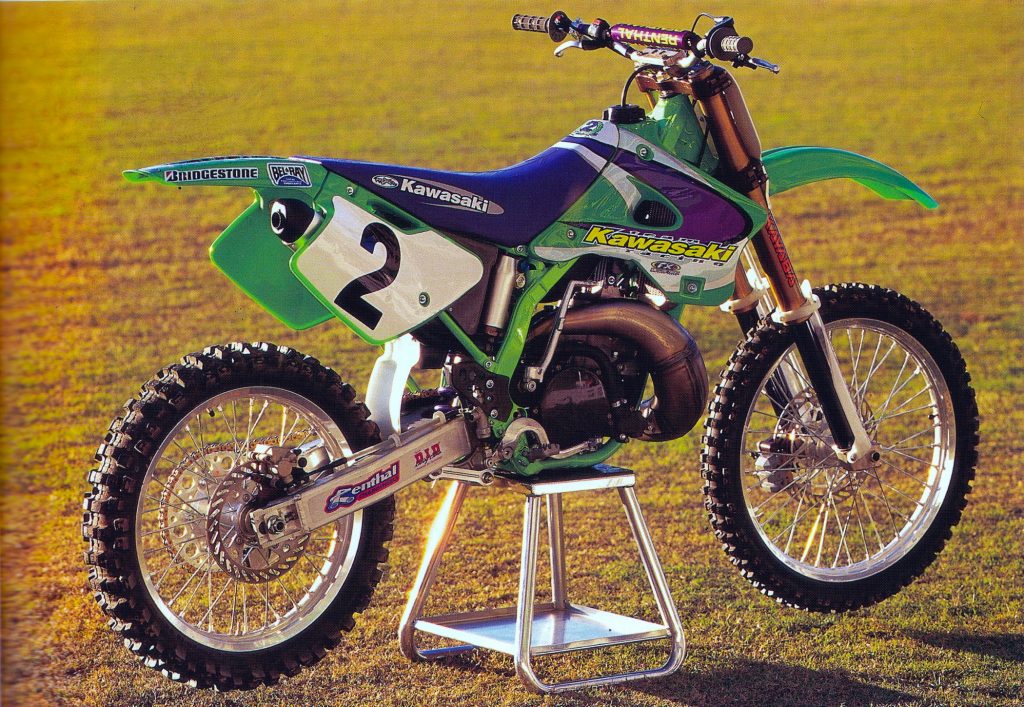 In 1996 Team Kawasaki unveiled one of the sweetest looking Factory bikes of all time. The works SR250’s of Damon Huffman, Ryan Hughes, and Jeff Emig positively glowed in their bright green livery. Even today, this is a great-looking motorcycle.
In 1996 Team Kawasaki unveiled one of the sweetest looking Factory bikes of all time. The works SR250’s of Damon Huffman, Ryan Hughes, and Jeff Emig positively glowed in their bright green livery. Even today, this is a great-looking motorcycle.
For Kawasaki, this adventure in styling by Crayola culminated in 1996 with its new KX250 motocrosser. All-new in 1994, the KX250 was in the third year of its five-year life cycle and looking to make a splash with some very unique styling choices. Where previous KXs had relied on purple as an accent, this new machine went all-in by coating the bike from stem to stern in grape flavoring. It was a move that excited some, confused others, and repulsed many.
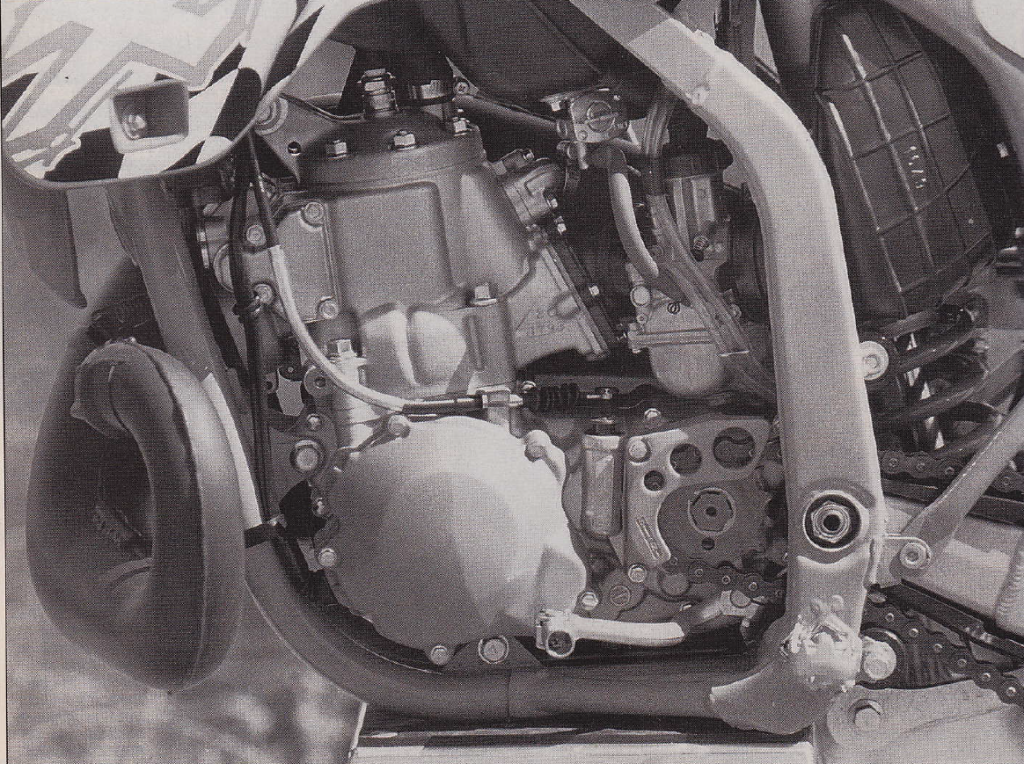
The 249cc mill on the KX250 was the master of blast in 1996. It pulled strongly from the first crack of the throttle and took off in the midrange like someone lit an afterburner. Its only faults were a notchy gearbox and a complete lack of overrev. Photo Credit: Motocross Action
Crazy color choices aside, the 1996 Kawasaki KX250 was actually not that much different from the bikes that Mike LaRocco and Mike Kiedrowski had campaigned the previous two years. In ’94, Kawasaki had totally revamped their deuce-and-a-half with an all-new motor and the third-generation of their steel perimeter chassis. The redesigned KX was well-liked for its strong low-to-mid delivery and ultra-plush suspension. The perimeter frame gave it a larger-than-average feel, but most people liked its handling and Motocross Action approved of it enough to award it the title of the best 250 of 1994.
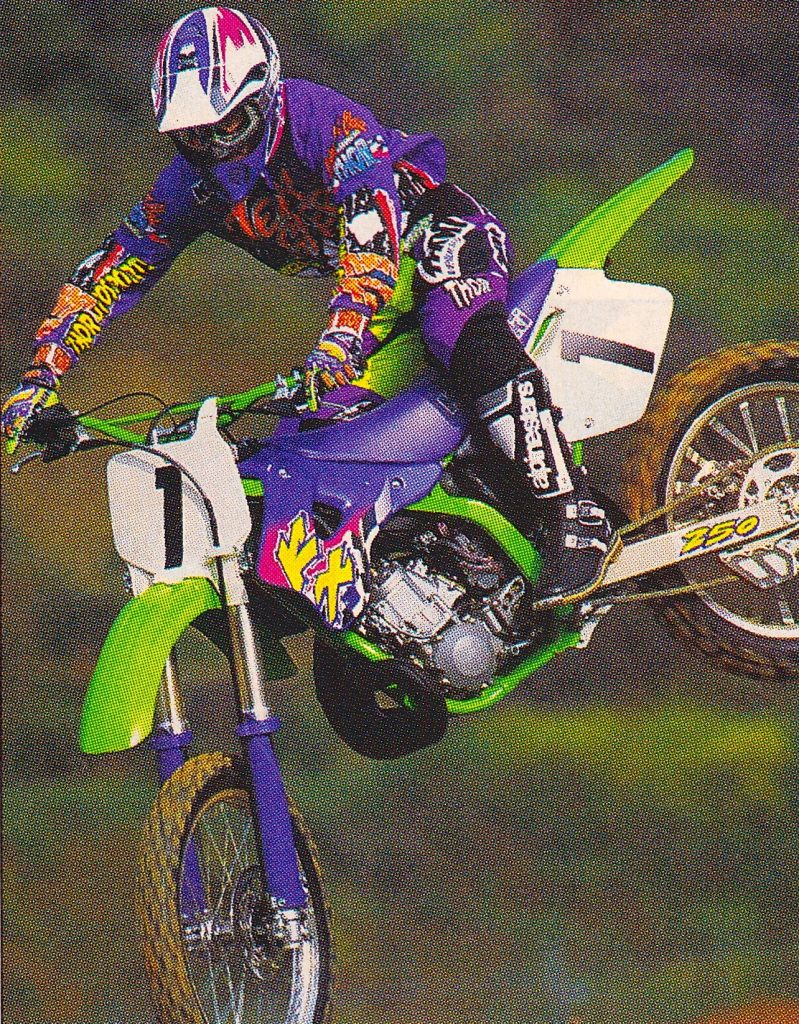
With its purple livery, the KX250 offered one of the more polarizing styling packages of 1996. Photo Credit: Dave Bush
For 1995, Kawasaki boosted the KX’s low-end and ended up with a very potent motocross package. The revised motor came on with a massive surge down low that sent the tire spinning and the front wheel climbing at the slightest crack of the throttle. Past the midrange, it just made noise, but it was wicked fast as long as you did not try to rev it too far. While competitively fast, its one-dimensional powerband found detractors at both ends of the spectrum. Novices thought its brutal hit was too abrupt and fast guys lamented its lack of overrev. Potent and punchy, the ’95 KX250 was fun to ride but demanding to race.
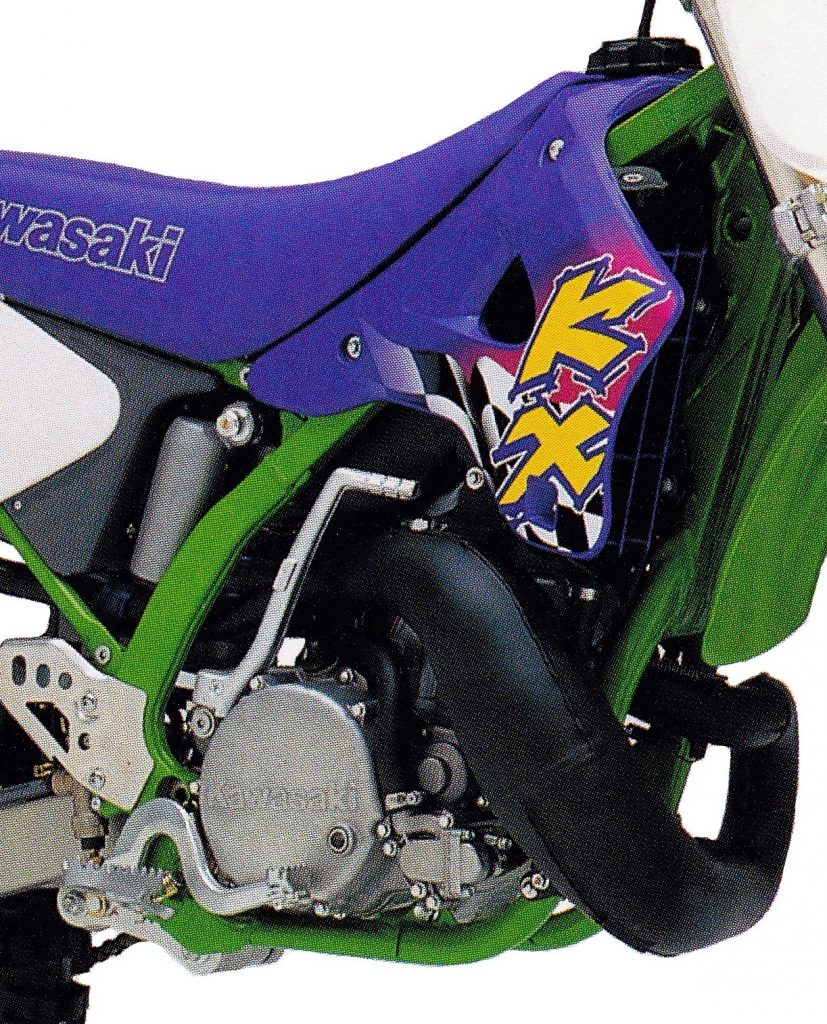 With 44.7 horsepower on tap, the KX was near the top of the power rankings in 1996 (only the KTM, at 45.4 HP made more). It was a great power plant for tight Supercross-style tracks, but its continuing lack of top-end hurt it on faster outdoor circuits. Photo Credit: Kawasaki
With 44.7 horsepower on tap, the KX was near the top of the power rankings in 1996 (only the KTM, at 45.4 HP made more). It was a great power plant for tight Supercross-style tracks, but its continuing lack of top-end hurt it on faster outdoor circuits. Photo Credit: Kawasaki
For 1996, Kawasaki aimed to make its Big Daddy Don Garlits powerband more manageable by mellowing out its explosive hit and lengthening its pull on top. In order to achieve this, Kawasaki stuck with tried and true methods to massage its potent power plant. Internally, the motor maintained the same bore and stroke as 1995 but added new porting and revised KIPS settings. A new digital ignition was installed and a revised expansion chamber was bolted on to beef up the top end. Finishing off the power package was an all-new 38mm Keihin PKW which featured small fins in the venturi to better control airflow into the motor.
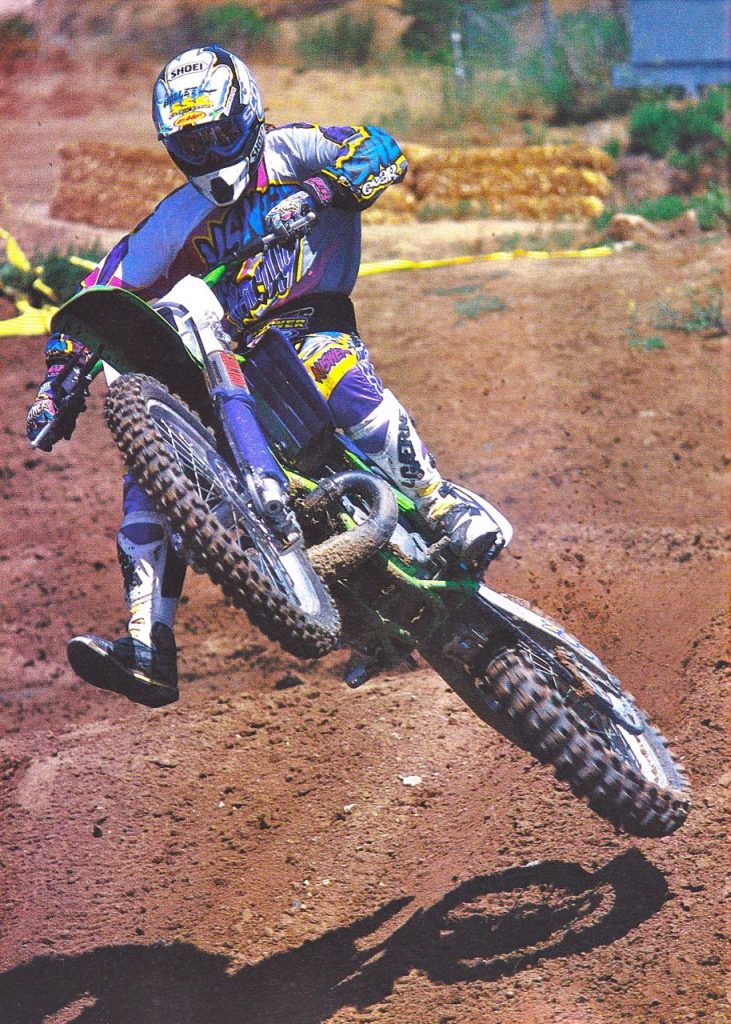 With a lightning-quick throttle response and massive midrange thrust, the ’96 KX250 practically leaped out of every corner. No run was too short for the mighty Kwacker. Brrraaaappppppp! Photo Credit: Dirt Bike
With a lightning-quick throttle response and massive midrange thrust, the ’96 KX250 practically leaped out of every corner. No run was too short for the mighty Kwacker. Brrraaaappppppp! Photo Credit: Dirt Bike
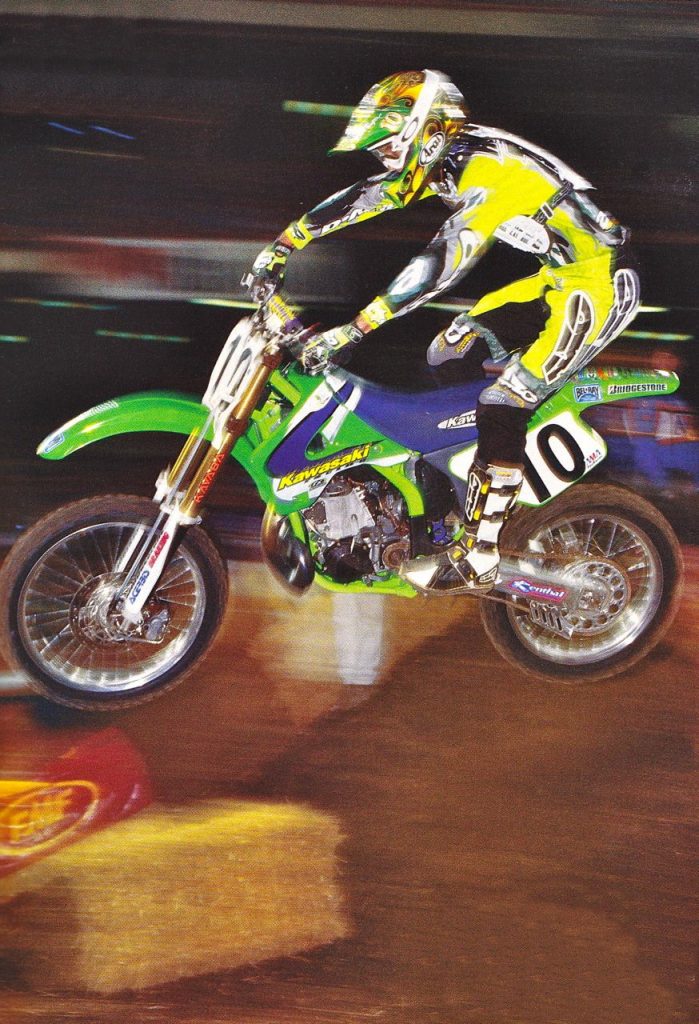 Out with the old and in with the new: In 1996, Kawasaki totally revamped its race team with an injection of new blood. Out were veterans Mike LaRocco and Mike Kiedrowski, to be replaced with young up-and-comers like Damon Huffman, Jeff Emig, and Ryan Hughes. Photo Credit: Chris Hultner
Out with the old and in with the new: In 1996, Kawasaki totally revamped its race team with an injection of new blood. Out were veterans Mike LaRocco and Mike Kiedrowski, to be replaced with young up-and-comers like Damon Huffman, Jeff Emig, and Ryan Hughes. Photo Credit: Chris Hultner
On the track, the 1996 KX250 mill turned out to be an improved version of the 1995 power plant. Kawasaki succeeded in keeping the best parts about the ’95’s beefy and burly low-to-mid powerband, while also taming its explosive delivery slightly. It still snapped to attention at first crack of the throttle but did a better job of putting that power to the ground without burning it up in useless tire smoke. The motor climbed onto the powerband with less explosion and more torque. The midrange was still super strong, but the more metered delivery allowed riders to make better use of it on tracks without perfect traction.

Batwings: One of the more interesting new features found on ‘96 KX250 were these tiny veins added to the venturi of the 38mm Keihin PKW carb. They were designed to improve the throttle response by increasing the laminar flow of air through the carb bore. Photo Credit: Dirt Bike
One area where the motor was not appreciably improved was on the top end. In spite of the new porting, ignition swaps and pipe rejiggering the motor continued to throw out the white flag when revved. Past its prodigious midrange hit, the KX would just make noise, demanding another shift to continue the fun. It was an awesome motor on tight Supercross style tracks, where its instant-on power could blast the KX up and over tricky obstacles with ease. On faster circuits, the Kwacker was still fast from corner to corner, but it required a lot of shifts to keep it in the sweet spot of its power. To make the most of the ’96 KX mill, quick reflexes and a fast left foot were mandatory.
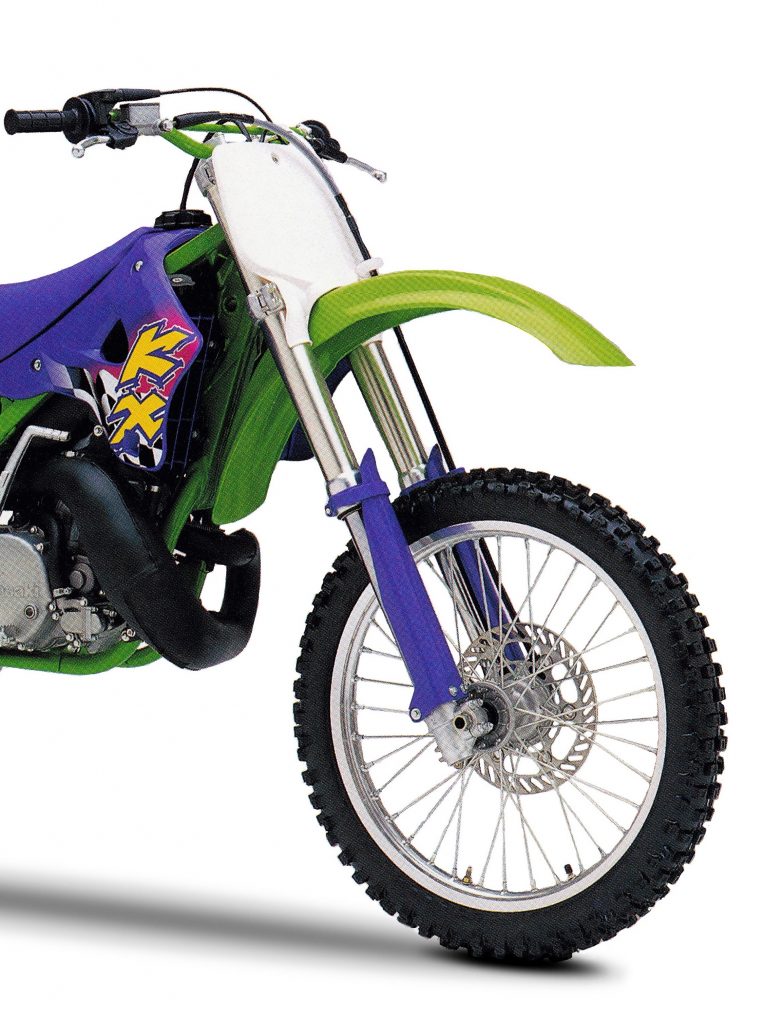
For ’96, Kawasaki beefed up the size of their Kayaba inverted front forks by 3mm to a 46mm. Unfortunately, that did little to aid their overly soft performance. With spring rates better suited to trail use, the KX was plush on small chop, but too soft for major aerial antics. Photo Credit: Kawasaki
In the hierarchy of ’96 motors, the KX ranked second behind the Honda’s excellent blend of meaty vibes and limitless rev. The Kawasaki offered a more robust low-end and stronger midrange hit but far less top end and inferior shifting. Behind the two front runners were the all-new RM250 and KTM. The RM featured a Honda-like powerband but less actual power. It was competitive in the right hands but a tick off the top two in outright performance.
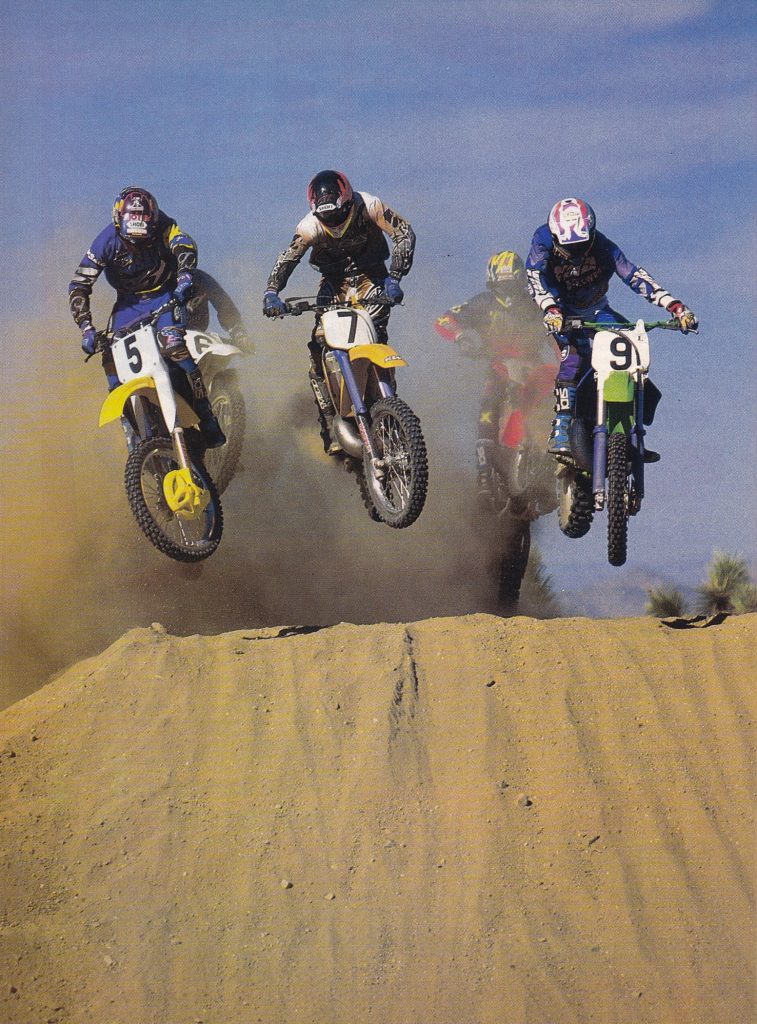
The 1996 250 class was a competitive group of machines, each with its own set of strengths and weaknesses. Photo Credit: Dirt Bike
The pumpkin-colored KTM, on the other hand, pumped out major dyno numbers (most in the class at 45.4 HP), but failed to translate them into competitive performance on the track. Its slow-revving enduro-like powerband worked well at gaining traction but made the bike feel lethargic and more appropriate to hopping logs than double jumps.
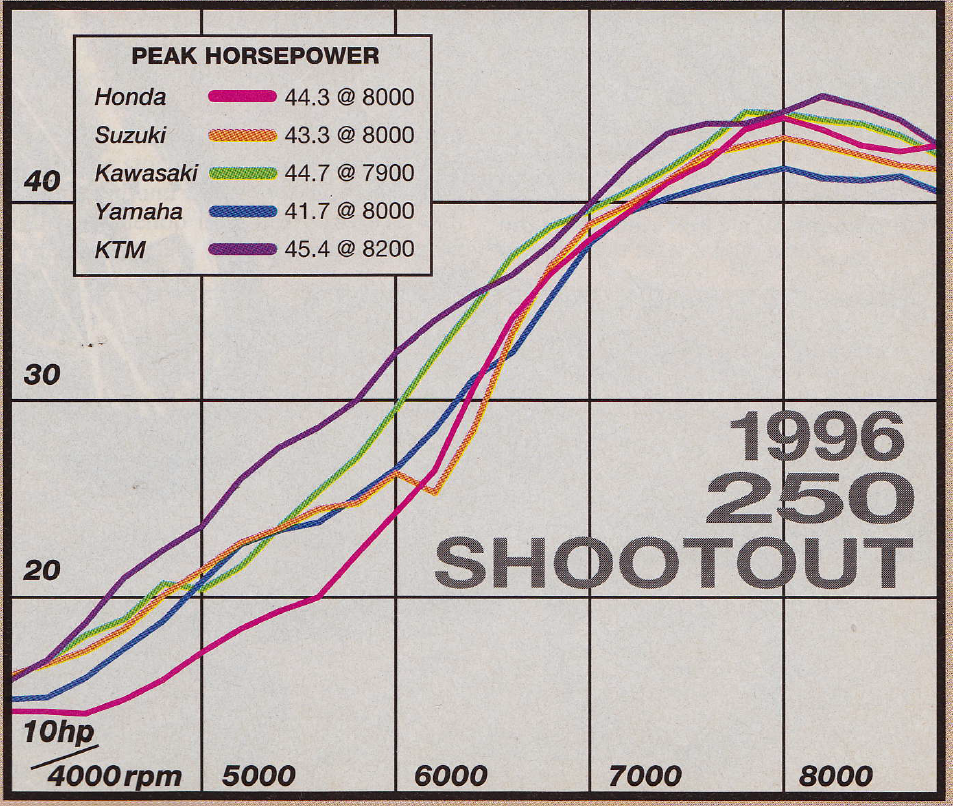
Dyno charts can often be misleading and this one for the 1996 250 crop certainly was. On paper, it looked like the KTM romped on all the competition, but on the track its slow-revving feel was unimpressive. In the real world, the blistering Honda and snappy Kawasaki bested all the rest by a sizable margin. Photo Credit: Dirt Bike
Bringing up the caboose of the ’96 standings was the redesigned YZ250. In ’95, the Yamaha had offered one of the best power packages on the track, but the all-new and all-blue machine was a bit of a mess in the power department for ’96. It gave up a full five horsepower to the top bikes in the class and made what little power it had over a very narrow spread. Of all the power packages of 1996, it was by far the least effective.
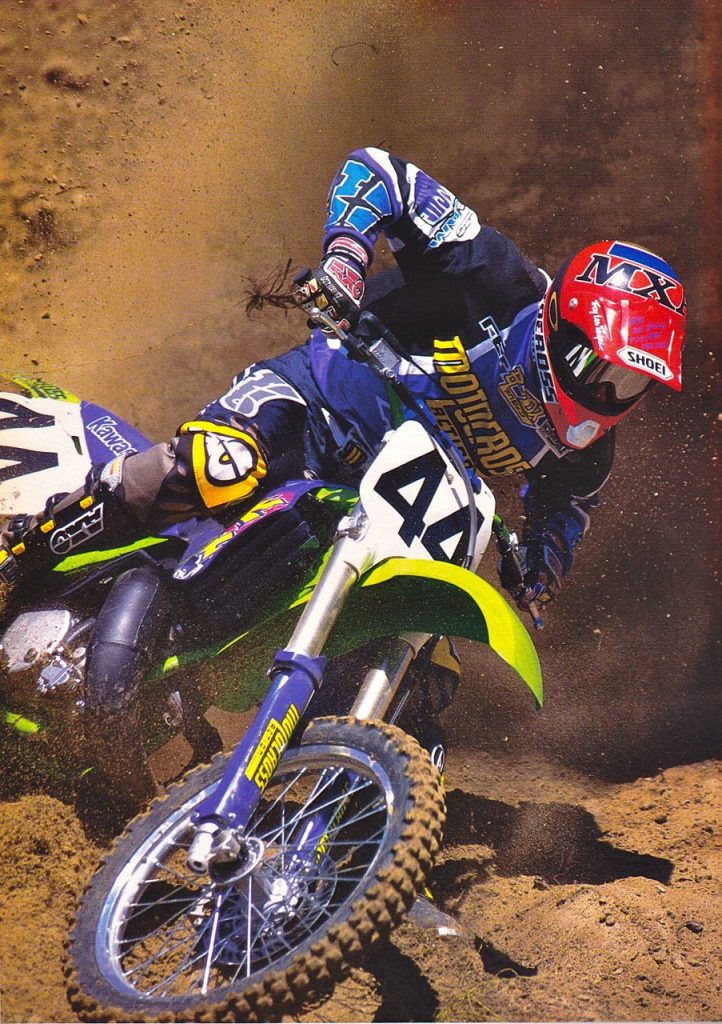 The sultan of snap: No soil was too deep for the mighty KX250 in 1996. With its burly low–end and massive midrange, you could bury the KX with the confidence that it would pull you through. Photo Credit: Motocross Action
The sultan of snap: No soil was too deep for the mighty KX250 in 1996. With its burly low–end and massive midrange, you could bury the KX with the confidence that it would pull you through. Photo Credit: Motocross Action
In the chassis department, Kawasaki made very few changes for 1996. When they had redesigned the KX in ’94, Team Green had nipped and tucked their previously luxo-liner sized machine down to a more manageable size. It was still the tallest, widest and heaviest chassis in motocross, but at least it no longer refused to change direction. For 1996, the only alterations made to the KX chassis was a slight increase in size to the lower frame cross member. Other than this tiny modification, it was same middle-of-the-road handler it had been the year before. That meant the KX turned well, but not as well as the Suzuki, and shook its head down fast straights, but not as badly as the Honda. It was a bit of a mixed bag that did everything adequately but impressed no one with its handling finesse.
On the suspension front, Kawasaki bucked the hot trend of the day by actually going bigger on their forks for ’96. At the time, there was still a great deal of backlash being heaped on the performance of the new inverted fork designs making their way through motocross. Riders and magazines were so vocal about this displeasure, that Suzuki and KTM both actually went back to right-side-up forks on their ’96 MX lines. It was clear the battle lines for fork supremacy were being drawn and the USD’s victory was far from assured.
 In 1996, Jeff Emig made the switch from long-time sponsor Yamaha to Kawasaki. Emig would have a fantastic year on the green machines, winning the St. Louis Supercross (and breaking McGrath’s unbeaten streak in the process), before catching fire late in the Nationals and claiming his first 250 National crown. Photo Credit: Motocross Action
In 1996, Jeff Emig made the switch from long-time sponsor Yamaha to Kawasaki. Emig would have a fantastic year on the green machines, winning the St. Louis Supercross (and breaking McGrath’s unbeaten streak in the process), before catching fire late in the Nationals and claiming his first 250 National crown. Photo Credit: Motocross Action
In spite of the general consensus at the time that fork flex might actually not be a totally bad thing, Kawasaki went jumbo for ’96. The new Grape Ape KX250 got its forks bumped up to supersize with a change from 43mm to 46mm. Along with the bigger stanchions, the Kayaba forks received larger internals, a larger cartridge, a larger piston, and increased volume. Overall travel remained unchanged at 12.2-inches of movement.
In the rear, Kawasaki went big once again with a larger shock piston and a more linear leverage ratio for the Uni-Trak linkage. This was basically a switch back to ratio of ’94 after riders were less than thrilled with its performance in ’95. As with the forks, travel remained unchanged from 1995 at 13.0-inches.
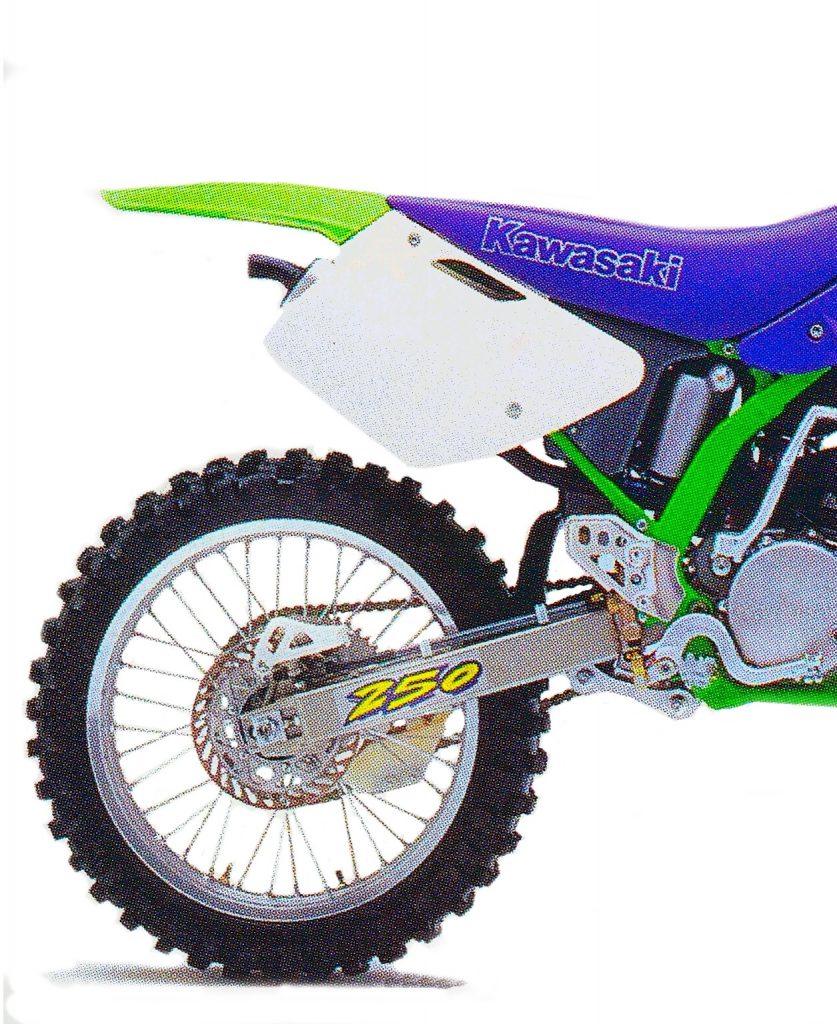
While the forks on the KX were tuned for trail use, the shock was set up for Supercross. Photo Credit: Kawasaki
In terms of performance, neither of the forks or shock ended up winning many fans in 1996. Up front, they were plush on small chatter but far too soft on hard hits. Major G-outs or serious jumps sent them blowing through the stroke and crashing to the stops. If you were fast, heavy, or both, you were sure to want stiffer springs and possibly a re-valve.
In the rear, it was the opposite problem. As delivered from the factory the stock rear was very stiff and harsh on small impacts. It kicked and chattered on breaking bumps but gobbled up large jumps and massive whoops without a whimper. For fast guys, this was a blessing but it put it completely out of step with the marshmallow-soft front forks. Until you fixed the front end, you were faced a perpetual stinkbug stance that played havoc with the bike’s handling.

The KX250 had more than enough boost to get you over any obstacle in 1996. Photo Credit: Dirt Bike
In the details department, the biggest news of ’96 had to be the KX’s switch to purple for its shrouds, fork guards, and graphics. Other than the new color pallet, the only notable changes were the use of a shorter front brake line and beefed up rear brake lever for ’96. It was no secret that Kawasaki had by far the worst brakes in motocross in the early nineties and these two changes were aimed at improving their woeful reputation. Both changes did yield small gains in brake feel, but the KX250 continued to suffer from the mushiest and most maintenance-intensive brakes in the class

One area where Kawasaki lagged well behind the competition in 1996 was in braking. Mushy in feel and in constant need of bleeding, these were the worst binders in motocross. Photo Credit: Kawasaki
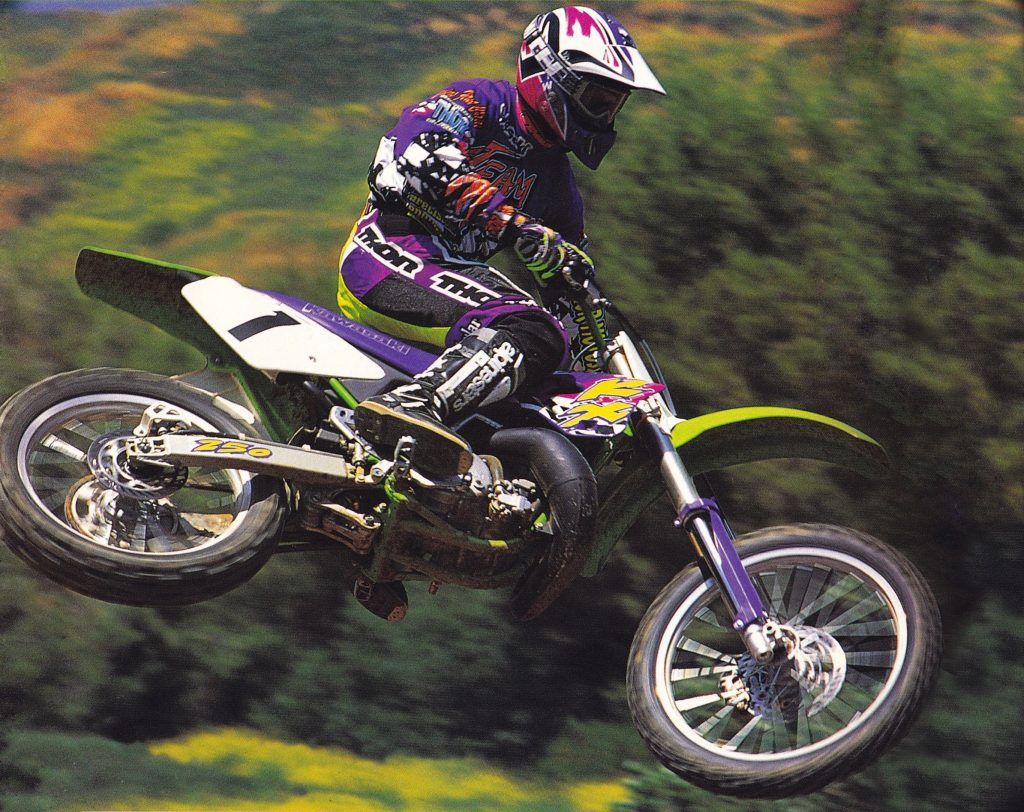
In ’96 Kawasaki offered one of the most fun bikes in motocross. The motor was a midrange rocket, which blasted the bike around the track and launched it out of every turn. It ripped holeshots and craved deep loam to roost on its lesser rivals. If only its suspension had not been so out of balance, it would have been the best 250 of 1996. Photo Credit: Dave Bush
In 1996, Kawasaki built a bike that was a few details short of greatness. It offered a powerful motor, that needed just a bit more rev and a solid chassis, which needed just a bit more polish. With the addition of a Pro Circuit pipe and a little suspension tuning, the KX became nearly unbeatable. It was a solid foundation, that was good enough to break Jeremy McGrath’s unbeaten streak in Supercross and capture the 1996 250 National Motocross title. As long as purple was your thing, it was a potent motocross weapon.
For your daily dose of old-school moto goodness, make sure to follow me on Twitter and Instagram @TonyBlazier




